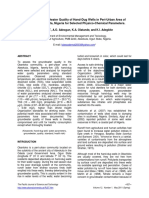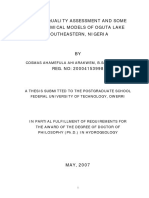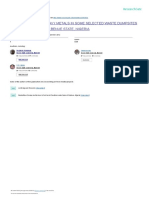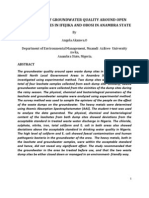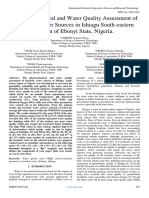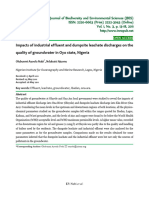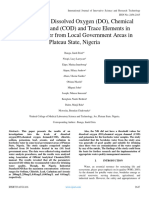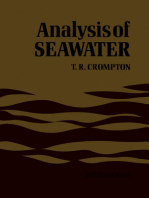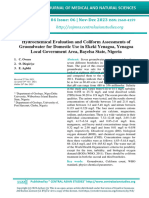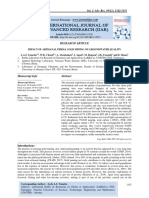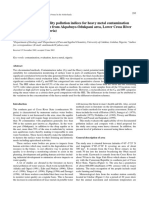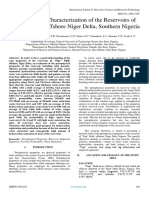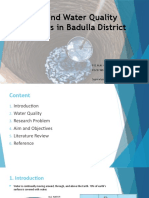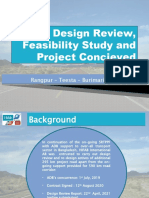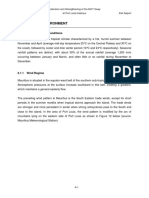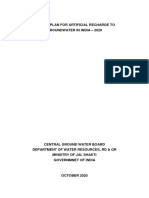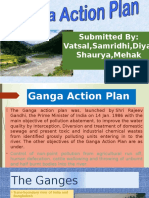Professional Documents
Culture Documents
Evaluating The Effects of Pollutants On Groundwater Quality in Okrika Nigeria
Original Title
Copyright
Available Formats
Share this document
Did you find this document useful?
Is this content inappropriate?
Report this DocumentCopyright:
Available Formats
Evaluating The Effects of Pollutants On Groundwater Quality in Okrika Nigeria
Copyright:
Available Formats
Volume 6, Issue 8, August – 2021 International Journal of Innovative Science and Research Technology
ISSN No:-2456-2165
Evaluating the Effects of Pollutants on Groundwater
Quality in Okrika Nigeria
Ogolo, l1,Abam T.K.S1* , Ngah, S.A 1 and Ujile, A. A2
1
Institute of Geosciences and Environmental Management (IGEM), Rivers State University, Port Harcourt, Nigeria
2
Department of Chemical Engineering, Rivers State University, PMB, 5080, Port Harcourt, Nigeria
Abstract:- The environmental quality of groundwater is 2018). These activities according to various studies have
very important to determine its suitability for drinking exposed pollutants into the drinking water system in the area
and agricultural purposes. The current status of which is sourced through groundwater in form of boreholes
groundwater in Okrika Local Government Area, Rivers and hand-dug wells. The quality of water is the degree of its
State, Nigeria and host to the Port Harcourt Refinery safety and hygienic conditions. Drinking water is said to be
Company was evaluated. A total of 20 samples from potable when such conditions are attained and it is
boreholes, were taken from Okrika island, Ogoloma, determined by the amount and level of physico-chemical,
OganAma, Kalio, George, Okari, Ekerekana, Abam, microbial and heavy metals (which included suspended and
Orupabo and Isaka Communities. The water samples dissolved substances in the water, the degree of alkalinity
were collected during the dry and wet seasons (pH), temperature, appearance in terms of colour, taste,
(February, July and November, 2020) and analyzed odour and the presence of non- desirable microorganisms).
using standard methods. The samples were analyzed for Water for domestic purposes should therefore be free from
the following parameters: pH, Temperature (T), these substances in order to prevent waterborne diseases.
Electrical Conductivity (EC), Total Dissolved Solids The understanding and monitoring of sources of water used
(TDS), Salinity, Turbidity, Chlorine, Bromine, Dissolved for water supply remains social, economic and
Oxygen (DO), Biochemical Oxygen Demand (BOD), conservational importance. This is necessary, since per
Nitrate, Phosphate, Cadmium (Cd) Lead (Pb) and capita water demand is increasing, while accessibility to
Zinc(Zn). Results obtained showed significant deviation freshwater availability has continued to decline. Studies
of some components from WHO standards. Water observed that potable water of communities in Okrika
samples showed that (80%) had pH concentration lower showed serious pollution from effect of refinery effluents.
than the WHO and NSDWQ Directive limit of 6.5 - 8.5 Also, water in Okrika is not suitable for drinking as well as
for potable water; DO and BOD values were below and other domestic purposes as a result of artisanal refining
above recommended limits of 6mgIL and 0.002 mg/L activities (Nwankwoala et al., 2017).
respectively. Four samples exceeded the WHO limit of
0.5mgIL phosphate in drinking water. The results of It has also been documented that drinking
Water Quality Index (WQI) rating in study area in the contaminated or polluted water can cause serious health
two seasons are above the standard rate which is an effects to humans and animals. Residents through long term
indication that the water is unfit for drinking. accumulation of these pollutants in form of heavy metals,
hydrocarbons, inorganic and organic acid will likely to
Keywords:- Groundwater, Water Quality, Pollutants Public cause cancer, kidney, liver diseases, etc. If the water
Health, Okrika. resource system is not treated, the current situation in the
area demands regular monitoring/surveillance of the water
I. INTRODUCTION resources system. This study will help update and increase
the database on the environmental quality of water in the
Groundwater in Okrika Local Government Area, area. The aim of this paper is to document the current status
Rivers State, Nigeria is polluted with discharges from the of the water system in Okrika Local Government Area.
Refinery, Fertilizer Company, other industrial activities, Towards this goal, relevant authorities can use the data to
crude oil bunkering, solid waste and sewage disposal. remediate heavily polluted areas, enforce strict regulations
Generally, petroleum refining has generated gaseous, liquid and laws concerning potable water, thereafter relevant
and solid wastes into the environment which include authorities can establish and maintain sustainable
draining fluid, petroleum waste water, petroleum effluent ecosystems in the area for future generations by appropriate
treatment plant sludge and bottom tank sludge (Johnson, remediation criteria.
IJISRT21AUG105 www.ijisrt.com 112
Volume 6, Issue 8, August – 2021 International Journal of Innovative Science and Research Technology
ISSN No:-2456-2165
II. STUDY AREA, GEOLOGY AND HYDROGEOLOGY OF THE AREA
Study Area
Fig. 1– Map of Nigeria and Rivers State showing study area
Fig. 2 – Map of Okrika Local Government Area showing Sampling Locations
IJISRT21AUG105 www.ijisrt.com 113
Volume 6, Issue 8, August – 2021 International Journal of Innovative Science and Research Technology
ISSN No:-2456-2165
Table 1: Coordinates of the Study Area (Okrika Local Government)
(a) Boreholes (Dry Season)
S/No. LOCATION CODES OWNERSHIP LATITUDE LONGITUDE TOWN
1. OG-Bd RSG 4°45'13.52"N 7° 5'33.37"E Ogan-Ama
2. OA-Bd Private 4°45'38.98"N 7° 5'45.28"E Orupabo-Ama
3. KA-Bd Private 4°45'35.74"N 7° 4'11.86"E Kalio-Ama
4. GA-Bd Private 4°45'11.93"N 7° 4'39.81"E Geoge-Ama
5. AA-Bd Private 4°45'42.17"N 7° 5'6.93"E Abam- Ama
6. BB-Bd Community 4°44'38.95"N 7° 5'22.83"E Bulome-biri
7. OL-Bd Private 4°44'42.93"N 7° 4'46.83"E Ogoloma
8. OK-Bd Private 4°44'19.18"N 7° 5'51.01"E Okari -Ama
9. EKBd Private 4°45'0.53"N 7° 5'59.64"E Ekerekana
(b) Boreholes (Wet Season)
S/No. LOCATION OWNERSHIP LATITUDE LONGITUDE TOWN
CODES
1. OG-Bw PHRC 4°45'3.10"N 7° 5'27.00"E Ogan-Ama
2. OA-Bw Private 4°45'38.98"N 7° 5'45.28"E Orupabo-Ama
3. KA-Bw Private 4°45'35.74"N 7° 4'11.86"E Kalio-Ama
4. GA-Bw Private 4°45'11.93"N 7° 4'39.81"E Geoge-Ama
5. AA-Bw Private 4°45'42.17"N 7° 5'6.93"E Abam- Ama
6. BB-Bw Community 4°44'38.95"N 7° 5'22.83"E Bulome-biri
7. OL-Bw Private 4°44'42.93"N 7° 4'46.83"E Ogoloma
8. OK-Bw Private 4°44'19.18"N 7° 5'51.01."E Okari- Ama
9. EKBw Private 4°45'0.53"N 7° 5'59.64"E Ekerekana
10. IS-BW Private 4°44'14.60"N 7° 0'4.43"E Isaka Town
11. IS-GW FGN 4°44'22.42"N 6°59'59.86"E Isaka Town
.
Okrika Local Government Area is located in Rivers winding creeks intersect it. There are within it stretches of
State in the Niger Delta region in the coastal part of the marshy land roots as the vegetation (Abam,, 2019). There is
South -South Nigeria (fig.1). The area lies between latitude also a mainland forest area within which the people have
4°44¹31. 74¹¹ N and longitude 7°051¹¹125¹¹E South of been carrying on with some farming from time to time.
Rivers State (Nigeria Federal Surveys, 2500/364/668). The Thus, though Okrika is primarily a riverine area, it also has
area is within the sub equatorial region of Nigeria. It is maintained settlements. Okrika area is drained by many
characterized by its beautiful beaches, mangroves, swamps rivers and creeks, the major river, which is Bonny River.
and barrier bars. The climate in Okrika is characterized
majorly by two seasons, the dry season begins in November Okrika is bounded to the North by Eleme Local
and ends in February, while the wet season begins in March Government Area, to the East by Ogu/Bolo Local
and ends in October, with a peak period in June and July,. Government Area, to the South by Bonny Local
Annual rainfall in the area is over 3000mm. Government Area. To the South-west by Degema Local
Government Area and to North-West by Port Harcourt city.
It is also characterized by high temperature and
humidity as is common with humid tropical climate. The area plays host to Port Harcourt Refinery
Average annual temperature in the area is about 27°C, with Company (PHRC) the Pipeline Product Marketing Company
maximum values in the months of March and April and the (PPMC), all subsidiaries of the Nigerian Petroleum
lowest in July and August. The climate conditions have an Corporation (NNPC) . The area is also host of the Okrika
intimate relationship with vegetation type in the area. The jetty and Terminal used for loading and unloading of oil and
high rainfall and humidity promote thick vegetation termed gas related activities. These had led to the continuous influx
tropical Rain forest. Topographic height rarely exceeds 80m of associated companies and people into the area thereby
in the area. Okrika is entirely within the tidal salt water resulting to increase in anthropogenic activities and
Zone of the Eastern Niger Delta, and a maze of rivers and corresponding discharge of pollutants into the environment
IJISRT21AUG105 www.ijisrt.com 114
Volume 6, Issue 8, August – 2021 International Journal of Innovative Science and Research Technology
ISSN No:-2456-2165
and the constant erosion of shorelines of the communities were transported to the laboratory in ice-packed coolers for
due to waves caused by ocean vessels. Okrika creeks are analysis according to APHA, 1998. The physico-chemical
used for effluent/waste drainage outlets from Port Harcourt properties of the borehole water samples were determined
Refinery and Former NAFCON, now Notore Fertilizer with the standard methods as highlighted in Table 4.
Company. Previous studies in these areas have indicated a Fourteen parameters were analysed and the results obtained
big pollution problem with these discharges and other are shown in Table 4.
effluents.
3.2 Determination of Water Quality Index (WQI)
Geology
The general geology of Okrika, which is also of Niger Water Quality Index Model
Delta consists of various types of Quaternary deposits Water Quality Index (WQI) is a very useful and
overlying the three major lithostratigraphic units. These are efficient method for assessing the suitability of water
from bottom to top, the Akata, Agbada and Benin quality. It is also a very useful tool for communicating
Formations. The Akata formation forms the basal unit of the information on overall quality of water (Jaji et al.,
Niger Delta and consists of an open marine facial unit 2007) to the concerned citizens and policy makers. It, thus,
dominated by high- pressured carbonaceous shale, the range becomes an important parameter for the assessment and
in thickness could exceed 1000 meters. It is overlain by the management of water quality (both surface and
Agbada Formation consisting of the alternating Deltaic groundwater). WQI reflects the composite influence of
sands and shales. It is Eocene to Oligocene in age and different water quality parameters and is calculated from the
exceeds 3000 meters in thickness. This Formation is oil point of view of the suitability of (both surface and
reservoir of the Niger Delta Basin. The overlying Benin groundwater) for human consumption. In general, water
Formation is Oligocene to Pleistocene in age and consists quality indices incorporate data from multiple water quality
predominantly of freshwater continual friable sands and parameters into a mathematical equation that rates the health
gravel that are of excellent aquifer properties with of waterbody with number (Akoteyon, et al 2011
occasional intercalation of shales. The thickness of the https://www.researchgate.net/publication/279900384). The
formation is variable but generally exceeds 2000 meters study assessed groundwater water quality for domestic use
(Avwenagha, et al., 2014). based on computed water quality index values as shown in
equation (1).
Hydrogeology
n Ap I p
Fresh water from the Benin Formation have been
identified as unconsolidated, highly porous sands. All Q p p 1 100 (1)
SI
aquifers in the Niger Delta are located within this p
lithostratigraphic unit. Also, in the Niger Delta, the regional
groundwater occurs in four major aquifers delineated from Where Qp= quality of parameters
lithologic and geophysical log within a depth bracket of 0 - Ap= average values of parameters determined under
300 meters. The first aquifer occurs between 0 -45m under laboratory conditions
phreatic conditions and is the most extensively exploited. S = standard permissible values obtained from recognized
The second (50 -130m) and the third (136 - 212m) are semi bodies
confined, while the fourth (219 - 300) is perfectly confined Ip= ideal values for the parameters.
and is the thickest. The aquifers are predominantly very fine All ideal values (Ip) are taken to be zero, except that of
to coarse grained sand beds with minor clays and pH=7; DO =14.6; Fluorides = 1 (Dakhad, et al, 2008).
conglomerate intercalations (Tse and Eshiemomo, 2016). The water quality index is determined by aggregating the
products of the parameter qualities and the unit weights
III. METHODOLOGY dividing by the aggregate of the unit weights as in equation
(2).
3.1 Sample Collection and Determination of n
physico-chemical parameters Q W
p 1
p p
Borehole and hand-dug well samples were obtained WQI n
(2)
from different communities in Okrika Local Government
Area, Rivers State, Nigeria during the dry (February) and W p 1
p
wet (July and November) seasons, 2020. All samples were
collected in properly rinsed bottles. The collected samples
IJISRT21AUG105 www.ijisrt.com 115
Volume 6, Issue 8, August – 2021 International Journal of Innovative Science and Research Technology
ISSN No:-2456-2165
The water quality ratings assigned to assigned to water quality index values are shown in table 1
TABLE 2: WATER QUALITY INDEX AND WATER STATUS
Water Quality Index Water Quality Status
0-25 Excellent
26-50 Good
51-75 Bad
76-100 Very bad
>100 Unfit for drinking
Source: Chatterji and Razuiddin(2002)
IV. RESULTS AND DISCUSSIONS
SAMPLE ID
U Mea Mi WH NSD
Parameters Unit AA- OL- BB- OG- GA- OK- EK- KA- OA- Std. Max
nit n n O WQ
Bd Bd Bd Bd Bd Bd Bd Bd Bd
6.5
– 6.5 –
1 pH 6.9 6.0 5.6 8.0 5.8 5.7 6.0 5.9 6.7 6.3 0.78 5.6 8.0 8.5 8.5
30.4
2 Temperature ˚C 31 30 30 31 31 30 30 30 31 4 0.53 30 31
Electrical us/c 115. 151.
3 Conductivity m 504 38 103 44 45 44 103 145 17 9 25 17 504 - 1500
Total Dissolved 91.6 148.
4 Solids(TDS) mg/l 475 23 73 77 30 25 18 89 15 7 53 15 475 600 1000
5 Salinity mg/l 1.0 1.0 1.0 1.0 1.0 1.0 1.0 1.79 1.0 1.09 0.26 1 1.79 200
NT 0.0
6 Turbidity U 0.01 0.01 0.01 0.01 0.01 0.01 0.01 0.01 0.01 0.01 0.00 1 0.01 5 5(10)
0.0 0.1 –
7 Chlorine mg/l 0.01 0.01 0.01 0.01 0.01 0.01 0.01 0.01 0.01 0.01 0.00 1 0.01 5 0.2
0.0
8 Bromine mg/l 0.01 0.01 0.01 0.01 0.01 0.01 0.01 0.01 0.01 0.01 0.00 1 0.01 0.05
Dissolved Oxygen
9 (DO) mg/l 0.9 0.7 0.5 0.7 1.6 1.5 0.5 0.8 1.3 0.94 0.42 0.5 1.6 6
Biochemical Oxygen 0.00
10 Demand (BOD) mg/l 0.7 1.1 1.0 0.7 0.7 1.1 1.3 0.9 0.2 0.85 0.32 0.2 1.3 2
0.18 0.22 0.15 0.63 1.63 0.26 0.11 0.19 0.1
11 Nitrate mg/l 0.294 1 2 9 8 5 9 6 3 0.41 0.48 2 1.64 50 50
0.07 0.05 0.08 0.13 0.10 0.05 0.01 0.09 0.0
12 Phosphate mg/l 0.098 5 8 1 2 9 8 7 2 0.08 0.03 2 0.13 0.5
Table 4: Physicochemical Parameters of Borehole Water Samples (Dry Season)
SAMPLE ID
Un Uni Me Mi M WH NSD
Parameters AA- OL- BB- OG- GA- OK- EK- KA- OA- Std.
it t an n ax O WQ
Bd Bd Bd Bd Bd Bd Bd Bd Bd
6.5
5. – 6.5 –
1 pH 6.9 6.0 5.6 8.0 5.8 5.7 6.0 5.9 6.7 6.3 0.78 6 8.0 8.5 8.5
30.
2 Temperature ˚C 31 30 30 31 31 30 30 30 31 44 0.53 30 31
us/c 115 151. 50
3 Electrical Conductivity m 504 38 103 44 45 44 103 145 17 .9 25 17 4 - 1500
Total Dissolved mg/ 91. 148. 47
4 Solids(TDS) l 475 23 73 77 30 25 18 89 15 67 53 15 5 600 1000
mg/ 1.0 1.7
5 Salinity l 1.0 1.0 1.0 1.0 1.0 1.0 1.0 1.79 1.0 9 0.26 1 9 200
NT 0.0 0. 0.0
6 Turbidity U 0.01 0.01 0.01 0.01 0.01 0.01 0.01 0.01 0.01 1 0.00 01 1 5 5(10)
mg/ 0.0 0. 0.0 0.1 –
7 Chlorine l 0.01 0.01 0.01 0.01 0.01 0.01 0.01 0.01 0.01 1 0.00 01 1 5 0.2
mg/ 0.0 0. 0.0 0.0
8 Bromine l 0.01 0.01 0.01 0.01 0.01 0.01 0.01 0.01 0.01 1 0.00 01 1 5
mg/ 0.9 0.
9 Dissolved Oxygen (DO) l 0.9 0.7 0.5 0.7 1.6 1.5 0.5 0.8 1.3 4 0.42 5 1.6 6
Biochemical Oxygen mg/ 0.8 0. 0.0
10 Demand (BOD) l 0.7 1.1 1.0 0.7 0.7 1.1 1.3 0.9 0.2 5 0.32 2 1.3 02
11 Nitrate mg/ 0.29 0.18 0.22 0.15 0.63 1.63 0.26 0.11 0.19 0.4 0.48 0. 1.6 50 50
IJISRT21AUG105 www.ijisrt.com 116
Volume 6, Issue 8, August – 2021 International Journal of Innovative Science and Research Technology
ISSN No:-2456-2165
l 4 1 2 9 8 5 9 6 3 1 12 4
mg/ 0.09 0.07 0.05 0.08 0.13 0.10 0.05 0.01 0.09 0.0 0. 0.1
12 Phosphate l 8 5 8 1 2 9 8 7 2 8 0.03 02 3 0.5
Table 5: Physicochemical Parameters of Borehole Water Samples (Wet Season)
Mea Mi Ma WH NSD
Std.
S/ UNI SAMPLE ID n n x O WQ
PARAMETERS
N TS AA OL BB OG GA OK EK KA OA IS- IS-
-B -B -B -B -B -B -B -B B B GB
5.6 5.3 5.1 5.4 5.9 5.0 5.8 5.6 5.2 6.4 5.5 5.0 6.5 –
1 pH 4 9 7 8 2 8 6 2 7 4 7 5.59 0.39 8 6.44 8.5 6.5 – 8.5
26. 26. 26. 26. 26. 27. 26. 26. 26. 28. 28. 26.9 26. 12 -
2 Temperature ˚C 9 6 6 4 4 3 8 4 4 3 4 5 0.74 4 28.4 24
us/c 150 170 150 160 160 140 160 170 130 540.6 170
3 Electrical Conductivity m 0 0 0 0 0 0 0 0 0 175 311 1307 5 175 0 - 1500
Total Dissolved Solids 96. 171 297.3 96.
4 (TDS) mg/l 825 935 825 880 880 770 880 935 715 25 .1 8118 5 3 935 600 1000
0.1 0.1 0.1 0.1 0.0 0.1 0.1 0.0 0.0
5 Salinity mg/l 0.1 14 0 07 07 94 07 14 87 66 96 14.8 33.40 9 96 200
0.3 0.3 0.2 0.1 0.3 0.2 0.3 0.2 0.2 0.2
6 Turbidity NTU 29 34 79 98 26 81 70 16 72 1 2 0.51 0.54 0 2 5 5(10)
0.0 0.0 0.0 0.0 0.0 0.0 0.0 0.0 0.0 0.0
7 Chlorine mg/l 1 1 1 1 1 1 1 1 1 20 29 8.92 20.22 1 29 5 0.1 – 0.2
0.0 0.0 0.0 0.0 0.0 0.0 0.0 0.0 0.0 0.0
8 Bromine mg/l 1 1 1 1 1 1 1 1 1 - - 0.01 0.00 1 0.01 0.05
9 Dissolved Oxygen (DO) mg/l 1.0 0.6 0.6 0.8 0.8 0.6 1.0 0.5 0.5 7.9 9.2 2.14 3.20 0.5 9.2 6
Biochemical Oxygen 0.5 0.2 0.2 0.00
10 Demand (BOD) mg/l 0.8 0.4 0.4 0.5 0.6 0.4 0.8 0.3 0.3 4 9 0.48 0.19 9 0.8 2
1.3 1.3 1.2 0.5 0.7 0.5 0.6 0.7 0.9 0.5
11 Nitrate mg/l 58 18 47 13 90 92 24 34 87 0.5 1.5 0.92 0.37 0 1.50 50 50
0.2 0.4 0.2 0.3 0.3 0.4 0.5 0.5 0.4 0.2 0.2
12 Phosphate mg/l 78 53 83 61 87 08 21 97 13 3 1.2 0.47 0.27 3 1.20 0.5
Table 6: Heavy Metals for Borehole Samples (Dry Season)
OG – B
OK – B
GA – B
KA – B
AA – B
OA – B
EK – B
BB – B
OL - B
PARAMETERS Mean Std. Min Max WHO NSDWQ
S/N
1 Cadmium (mg/l) 0.001 0.001 0.001 0.016 0.052 0.001 0.001 0.001 0.071 0.02 0.00 0.001 0.071 0.003 0.01
0.002 0.002 0.002 0.002 0.002 0.002 0.002 0.002 0.002
2 Lead (mg/l) 0.002 0.00 0.002 0.002 0.003 0.01
0.005 0.005 0.005 0.005 0.005 0.005 0.005 0.005 0.005
3 Zinc (mg/l) 0.005 0.00 0.005 0.005 3.0
Table 7: Heavy Metals for Borehole Samples (Wet Season)
IS - GB
S/
OG – B
GA – B
KA – B
AA – B
OA – B
OK – B
EK – B
BB – B
OL – B
Mea Std WH NSDW
IS – B
N Parameters Min Max
n . O Q
Cadmium 0.00 0.00 0.00 0.00 0.00 0.00 0.00 0.00 0.00 0.00 0.00 0.00 0.0 0.00 0.00 0.00
1 (mg/l) 1 1 1 1 1 1 1 1 1 1 1 1 0 1 1 3 0.01
0.00 0.00 0.00 0.00 0.00 0.00 0.00 0.00 0.00 0.00 0.00 0.00 0.0 0.00 0.00 0.00
2 Lead (mg/l) 1 1 1 1 1 1 1 1 1 1 1 1 0 1 1 3 0.01
0.00 0.00 0.00 0.03 0.00 0.00 0.00 0.00 0.05 0.00 0.00 0.00 0.0 0.00 0.05
3 Zinc (mg/l) 1 1 1 9 1 1 1 1 2 1 1 8 0 1 2 3.0
IJISRT21AUG105 www.ijisrt.com 117
Volume 6, Issue 8, August – 2021 International Journal of Innovative Science and Research Technology
ISSN No:-2456-2165
RESULTS Dissolved Oxygen
Dissolved oxygen values for borehole water samples in
pH dry season ranged from 0.5 mg/l to 1.6mg/l with a mean
pH values for borehole sample during the dry season value of 0.94mg/l.
ranged from 5.6 to 8.0 with a mean value of 6.3. The highest
recorded occurred in O.G-B (8.0) while the lowest occurred For wet season, dissolved oxygen values ranged from
in Bulome-biri borehole (BB-B) at 5.6. 0.5mg/l to 9.2mg/l with a mean value of 2.14mg/l. The
highest concentration value of 9.2mg/l was recorded in IS -
For wet season, the borehole samples ranged from 5.08 GB while the lowest value of 0.5mg/l was recorded in KA-B
to 6.44. The highest recorded pH occurred in IS-B (6.44) and OA - BB respectively.
and the lowest in OK-B (5.08) the results show that none of
the boreholes had acceptable pH values of 6.5 - 8.5. Biochemical Oxygen Demand
Biochemical Oxygen Demand (BOD) values for
Temperature borehole water samples in dry season from 0.2mg/l to
Water temperature values for the borehole samples in 1.6mg/l with a mean value of 9.77mg/l.
dry season ranged from 30°C to 31°C. For wet season,
water temperature values for the borehole samples ranged For wet season, Biochemical Oxygen Demand values
from 26.4°C to 28.4°C with the mean value of 26.9°C. ranged from 0.29mg/l to 0.8mg/l with a mean value of
0.48mg/l.
Electrical Conductivity
Electrical conductivity values in dry season for Nitrate
borehole ranged from 17s/cm to 504s/cm with mean Nitrate values in dry season ranged from 0.116mg/l to
value of 115.8 S/cm for wet season, Electrical 1.635mg/l with a mean value of 0.411mg/l. For wet season,
Conductivity values ranged from 311 S/cm to 1700 S/cm Nitrate values ranged from 0.5mg/l to 1.5mg/l with a mean
with a mean value of 1307 s/cm. value of 0.92mg/l.
Total Dissolved Solids Phosphate
The values of Total Dissolved Solids (TDS) value in Phosphate values in dry season ranged from 0.017mg/l
borehole water samples during the dry season ranged from to 0.132mg/l with a mean value of 0.72mg/l. For wet
15 - 475mg/l with the mean valve of 91.7mg/l. The /highest season, Phosphate values ranged from 0.23mg/l to 1.20mg/l
value was recorded in AA - B with value of 475mg/l while with a mean value of 0.466mg/l.
the lowest value was recorded in OA- B as 15mg/l.
Heavy Metals
For wet season, Total Dissolved Solids (TDS) value
ranged from 96.25mg/l - 935 mg/l with a mean value of Cadmium
719.30mg/l. Cadmium values in dry season ranged from 0.001mg/l
to 0.071mg/l with a mean value of 0.020mg/l. The Highest
Salinity value of 0.071mgIL in OL-B (Ogoloma) while the lowest
Salinity values for boreholes in dry season ranged values of 0.001mg/I was recorded in AA-B (Abam-Ama),
from 1.0 mg/l to 1.79mg/l. For wet season, Salinity values BB-B (Bulome-biri), OG-B (Ogan), OK-B (Okari-Ama),
ranged from 0.087 mg/l to 96mg/l with a mean value of EK-B (Ekerekana) and OA-B (Orupabo-Ama) respectively.
14.83mg/l. In wet season, Cadmium values of 0.001mg/l was recorded
in all the boreholes.
Turbidity
Turbidity values for borehole water samples in the dry Lead
season recorded 0.01 NTU in all water samples. For wet Lead values in dry season for borehole water samples
season, Turbidity values ranged from 0.198 NTU to 2 NTU recorded 0.002 mg/l in all the boreholes.
with mean value of 0.509 NTU.
Zinc
Chlorine Zinc value in dry season was recorded 0.0005 mg/l for
Chlorine values for borehole water samples in dry all boreholes.
season recorded 0.01mg/l in all the water samples. For wet For wet season, Zinc value ranged from 0.001mg/l to
season, Chlorine values ranged from 0.1 to 58mg/l with 0.052mg/l with a mean value of 0.008; the highest
mean value of 8.91mg/l. 0.052mg/l was recorded in OK-B (Okari-Ama).
Bromine DISCUSSION
Bromine values for borehole water samples in dry
season recorded 0.01mg/l in all the boreholes. For wet Temperature
season, the same bromine values of 0.01mg/l were recorded Temperature values were between 30°c to 31°c for
for all borehole water samples. borehole during the dry season while temperature value for
boreholes were between 26.4°c - 28.5°c during the wet
IJISRT21AUG105 www.ijisrt.com 118
Volume 6, Issue 8, August – 2021 International Journal of Innovative Science and Research Technology
ISSN No:-2456-2165
season. Temperature changes in physical, chemical and Salinity
microbial processes in the sub surface environmental Drinking water salinity has been linked to risk of
leading to groundwater quality changes (Bonte et al.,2011, preeclampisa and gestational hypertension. Over extraction
Hahnlein et al.,2013). of groundwater may cause salinity in water.
Cool water is generally more palatable than warm The salinity values for boreholes and were all very low
water. High temperature most times may increase problems expect the boreholes at Isaka Town, which were recorded
related to taste, odour, colour and corrosion and also 66mg/l and 96mg/l respectively. This values although not up
enhance the growth of microorganism. (WHO,2017). The to the WHO. Guideline value of 200mg/I are lower
temperature of 31°c is into within the permissible limit of compared to the value of 170mg/I reported by Chakraborty
World Health Organization ( WHO) Ezeribe et al.,(2012) et al., (2019). Increased water salinity may lead to infant
reported result of 29°c of well water. However, the aesthetic mortality, cholera outbreaks, skin and diarrheal diseases.
objective for water temperature in the guidelines for
Canadian Drinking Water Quality is 15°c. Turbidity
In drinking water, the higher the turbidity level the
Electrical Conductivity higher the risk that people may develop gastrointestinal
Electrical Conductivity values for borehole for dry and wet diseases. This is worse for people with low immunity.
seasons ranged from 17us/cm - 1700us/cm. Turbidity is a measure of the light refractiveness of water. It
is a very important parameter for water quality. Some
According to National Drinking Water Quality problematc particles in turbid water can include metals or
Standards (NDWQS),all boreholes during wet season were other types of sediment that can negatively, affect human
above allowable limits of 1500 us/cm except Isaka borehole health. These particles can harbour microorganisms,
and Government borehole (175 and 311 us/cm). Using protecting them from disinfection, also trap heavy
Jordania Standards and Guideline for drinking water, with metals(Government of Canada,2020). Turbidity values from
the allowable limit of 400us/cm, one borehole (Abam Ama) all boreholes for dry and wet seasons recorded were below
during the dry season was above the limit, all boreholes the allowable limits of 5 NTU for WHO and NSDWQ.
during wet season except Isaka Town, during the wet WHO established that the turbidity for drinking water
season were above the guideline. During raining season, should not be more than 5NTU and should be ideally below
Inam and Offiong, 2017 recorded 65.75us/cm. Electrical 1NTU. The levels in the two boreholes (IS-B and IS-GB)
Conductivity is a measure of water capacity to convey which are 1NTU and 2NTU are therefor above the ideal
electric current. Dissolved salts and other inorganic allowable limit. However, the European Standards for
chemicals conduct electrical current, conductivity increases turbidity states that it must be no more than 4NTU.
as salinity increases. Subsequently, Conductivity is also Canadian guideline is between 0.1 to 1.0 NTU. Inam and
affected by temperature. The warmer the water, the higher Offiong (2017) during dry season recorded 13.08 NTU
the conductivity. Conductivity is an early indication of which is higher.
change in a water system. This can be used to determine
saltwater intrusion in groundwater ( Atkins,2020). Pure Chlorine
water is not a good conductor of electricity (Alley, 2007; High Chlorine in drinking water may not hurt at first
APHA,2005). but may have long term health effects. Increased risk of
cancer, hazardous for children's health, cell damage and
Total Dissolved Solids (TDS) increase the risk of Asthma and some of the effects. Cancer
The palatability of water with a Total Dissolved Solids risk among people drinking chlorinated water is 93 percent
(TDS) level of loss than about 600mg/I is considered to be higher than those who drink water without chlorine
good. Drinking water becomes unpalatable as TDA levels is (Wiant,2019).
greater than 100mg/I (WHO,2017). TDS values for
boreholes during the dry season were all below the The chlorine values for all the boreholes were below
allowable limit of 600mg/I while during the wet season, 0.01mg/I except the boreholes at Isaka Town which
only boreholes at Isaka Town were within allowable limit, recorded 20mg/I and 29mg/I.
all the other boreholes were above 600mg/I. However,
allowable limit for US Environmental Protection Agency is The allowable limit for chlorine is 5mg/I (WHO,2017)
500mg/I. while it is 4mg/I (USEPA,2018). Chlorine in Isaka Town
maybe as a result of industrial activities around the area.
TDS is non - ionized matter. Where TDS is high, the water
may be saline. High TDS in drinking water can cause Bromine
organoleptic implications (EPA,2001). Bromine in drinking water can cause different effects
depending on the compound. This could in a short period of
This may be attributed to the presence of natural solute time cause symptoms such as nausea and vomiting (
or from industrial treatment plants or groundwaters gastrointestinal symptoms). It is also corrosive to human
pollution. TDS values of groundwater samples tissue in liquid state, malfunctioning of the nervous system,
559.2589.7,319.5 and 247.5mg/I were obtained in Lagos disturbances in genetic materials and damage to the thyroid
Metropolis (Popoola, et al.,2019). gland.
IJISRT21AUG105 www.ijisrt.com 119
Volume 6, Issue 8, August – 2021 International Journal of Innovative Science and Research Technology
ISSN No:-2456-2165
Bromine values for all boreholes during the dry and Heavy Metals
wet seasons were at 0.01mg/I. The values recorded were Cadmium (Cd)
within the guideline value of 0.05mg/l(WHO). Heavy metals are toxic to humans and to fish. They
easily accumulate in fish and other tissue, therefore liable to
Dissolved Oxygen enter food chain. Cadmium (Cd) in water is due to industrial
Dissolved Oxygen (DO) is a measurement of how discharges and leachates. Cadmium is highly toxic, therefore
much Oxygen is dissolved in water. DO can tell a lot about severe restrictions on its concentration in water has been
water. formulated. It is released into the environment in wastewater
and pollution by contamination from fertilizers, fossil fuels,
The DO values for boreholes during dry season as 0.9, coal, lead and copper ores. The physiological effects of
0.7, 0.5, 0.7, 1.6, 1.5, 0.5, 0.8, 1.3, 1.3mg/1 respectively Cadmium are bone damage, chronic kidney disease, cancer
while for the wet season, it was recorded as 1.0, 0.6, 0.6, and hypertension. Cadmium values in borehole water
0.8, 0.8, 0.6, 1.0, 0.5, 0.5, 7.9, 9.2mg/1 respectively. sample during the dry season recorded 0.001mg/1 except
boreholes in Ogoloma (0.071mg/1), George-Ama
However, the boreholes at Isaka Town had higher (0.016mg/1) and Kalio-Ama (0.052mg/1). During the wet
values of 7.9 and 9.2mg/1. With the guideline limit of season, all boreholes recorded 0.001mg/1.
7.5mg/1 (EQS Japan, 2015), the values recorded in Isaka
Town were above the limit. WHO value is 6mgil. WHO Guideline values for Cadmium is 0.003mg/1.
Also, NSDWQ guideline value is 0.003mg/1.
Biochemical Oxygen Demand (BOD)
BOD gives a measure of Oxygen requirement for Lead
biodegradation of Carbonaceous matter in a simple. The Lead originated from effluent discharges which attack
BOD values for all boreholes were all below 1mg/1 except - water pipes. Lead has toxic cumulative poison. It is one of
Ogoloma (1.1), Bulomebiri (1), Okari Borehole (1.1), the most commonly determined heavy metals. Exposure to
Ekerekana (1.3) during the dry season. With the guideline lead include neurodevelopmental effects, mortality (due to
limit of 1mg/1 (Environmental Quality Standard ( EQS, cardiovascular disease), impaired renal function,
Japan), four of the boreholes are above the allowable limit. hypertension, impaired fertility and adverse pregnancy
WHO (2017) limit for BOD is 0.002mg/l. Adesuyi outcomes. Damage to nervous system and red blood cells.
etal.,(2015) also had almost similar value of 1.0-2.0mgil.
Lead values of 0.002mg/1 was recorded during the dry
Nitrate season in all the boreholes and 0.001mg/1 during the wet
Consuming much nitrate can affect how blood carries season all samples were within the limit of 0.01mg/l. The
Oxygen and cause methemoglobinemia (also known as blue guideline limit for lead is 0.01mg/1 for WHO and NSDWQ.
baby-Hazard to infants above 11mg/1(EPA, 2001). Presence USEPA Action is 0.015mg/l while for Maximum
of nitrate in ground waters is a risk to babies of less than six Contaminant Goal Limit is 0.00mg/l
months and unborn foetus of pregnant women. Adults with
specific rare metabolic disorders may also be at risk. Zinc (Zn)
This occurs from wastes and natural geological
Nitrate levels for all boreholes were within the occurrences. It is essential to man but if ingested in large
allowable limit of 50mgil. 11mg/1 for babies (infants) and amounts, it has a bad effect, like stomach cramps, nausea
50mg/ 1 for adults. Inam and Offiong (2017) in their study and vomiting. Water with a Zinc concentration of more than
also recorded nitrate value (mg/1) 0.910 in dry season and 5mg/1 may become chalky in appearance with a delectable
0.002 in wet season. Similar findings of 0.002 to 0.054mgil, deterioration in taste. Zinc in water through wastewater
(Musa et al., 2014). releases, industrial methods involving metals and
atmospheric outcomes. Zinc inhalation can cause
Phosphates neurological toxicity, dizziness, pain, headache and
Phosphate levels in all the boreholes during the dry tiredness (Sankhla et al., 2019)
and wet seasons were below 1mg/1. This is compared to
United Kingdom drinking water standard. Phosphate Zinc values for all boreholes during the dry season
concentrations of (1mg/l). However, too much phosphate recorded 0.005mg/1 while during the wet season, all
can cause health problems such as kidney damage and boreholes recorded 0.001mg/1 except Okari-Ama
osteoporosis. Phosphate shortages can occur due to (0.052mg/1) and Kalio-Ama (0.039).
extensive use of medicine. Also, too little can cause
problems. WHO and NSDWQ guidelines limit for Zinc is 3mg/1.
Jordian guideline for Zinc is at 0.01mg/1. Therefore, traces
of Zinc metal were eminent in these boreholes. Zinc values
in this study can be compared to values reported by Ubong
et al. (2016), which ranged from 0.76mg/l to 0.185mg/l.
IJISRT21AUG105 www.ijisrt.com 120
Volume 6, Issue 8, August – 2021 International Journal of Innovative Science and Research Technology
ISSN No:-2456-2165
RESULTS OF WQI OF GROUNDWATER FROM OKRIKA AND ITS ENVIRONS
TABLE 8: WET SEASON
Parameter Observed Value Standard Value Unit Weight (Wp) Quality Rating WQI (WpQ p)
(WHO) (Q p)
pH 5.59 6.5-8.5 0.011 282 3.102
Electrical 1307 1000 0.0050 130.7 0.654
Conductivity
TDS 8118 600 0.052 1353 70.356
Salinity 14.8 200 0.0002822 7.4 0.0021
Turbidity 0.51 5 0.0004004 10.5 0.004204
Chlorine 8.92 5 0.006788 178 1.208
Bromine 0.01 0.05 0.0007627 20 0.015
DO 2.14 6 0.005525 144.884 0.80
BOD 0.48 0.002 0.915 24000 21960
Nitrate 0.92 50 0.0000702 1.84 0.0001292
Phosphate 0.47 0.5 0.003585 94 0.337
TOTAL
W p 1 26222 26240
TABLE 9: DRY SEASON
Parameter Observed Value Standard Value Unit Weight (Wp) Quality Rating WQI (WpQ p)
(WHO) (Q p)
pH 6.3 7.5 0.003266 140 0.457
Electrical 115.9 1000 0.0002706 11.6 0.00314
Conductivity
TDS 91.67 600 0.000357 15.3 0.005462
Salinity 1.09 200 0.00001272 0.545 0.0000070
Turbidity 0.01 5 0.0000047 0.2 0.00000094
Chlorine 0.01 5 0.0000047 0.2 0.00000094
Bromine 0.01 0.05 0.0000047 20 0.0094
DO 0.94 6 0.00371 158.84 0.590
BOD 0.85 0.002 0.992 42500 42160
Nitrate 0.41 50 0.00001913 0.82 0.0000157
Phosphate 0.08 0.5 0.0003733 16.0 0.005973
TOTAL
W p 1 42860
The analysis has shown that the water status for wet refining of crude oil in the area should be brought under
and dry season is unfit for drinking. control.
V. CONCLUSION REFERENCES
The evaluation of the parameters that determine the [1]. Abam, A.S. (2019). The Okrika Kingdom : An
level of contaminants to groundwater has been carried out. Analysis of the Dynamics of Historical Events
The methodology adopted is the standard one. The (Second Edition). Doval Ventures Ltd. Port Harcourt,
Biochemical Oxygen Demand (BOD) values obtained which Rivers State, Nigeria.
reflect the Water Quality Index status is a key parameter that [2]. Atkins, J. (2020). What is Electrical Conductivity and
should be investigated further. The inference drawn for the why it is important? Aqua read -Water Monitoring
study shows that the effluents from the process industries Instruments. Blog: Retina Blog by Tienenatic Team.
have impact on the groundwater resource. [3]. Chakraborty, R., Khan, K M. and Islam, M.S. (2019).
Health Implications of Drinking Water Salinity in
The results from the area under study (Okrika Local coastal Areas of Bangladesh. International Journal of
Government Area) showed that water within the study area Eviron. Res. Public Health, 16 (19).
is not suitable for drinking. It is therefore imperative for [4]. Chatterji, C and Raziuddin,M (2002) Determination of
relevant Agencies of Government; Local Government, State water quality index(W.Q.I) of a degraded river in
and Federal Government to monitor and regulate the Asanil industrial area,
activities of the process industries around Okrika Local Ranigunj,Burdwan,wetBengal.Nature,Environment
Government. Besides, activities of illegal and unsafe and pollution Technology.1(2):181-189.
IJISRT21AUG105 www.ijisrt.com 121
Volume 6, Issue 8, August – 2021 International Journal of Innovative Science and Research Technology
ISSN No:-2456-2165
[5]. Dhakad,N.K.,Deepak,S and Choudhary,P [21]. Nwankwoala, H.O. and Ngah,S.A. (2013). Salinity
(2008).Water quality index of Ground water(GWQI) Dynamics : Trends and vulnerability of aquifers to
of Jhabua Town, M.P(India).Journal of Environmental contamination in the Niger Delta.
Research and Development2(3):443-446. [22]. Ubong, I.U., Ogolo, I., Abam, T.K.S. and Ngah, S.A.
[6]. Environmental Protection Agency. (2001). Parameters (2016). Physicochemical and Heavy Mental Contents
of Water Quality : Interpretation and Standard. of Groundwater in Okrika Mainland, Rivers State.,R.A
Publisher : Environmental Protection Agency. Ireland. Journal of Research, 2 (8); 558-567. [24].
[7]. Inam, E. and Offiong, N. (2017). Physicochemical [23]. https://www.researchgate.net/publication/279900384_
Characteristics and Health Risk Assessment of Determination_of_water_quality_index_and_suitabilit
Drinking Water sources in Okoro Ette Community, y_of_Urban_River_for_municipal_water_supply_in_L
Eastern Coast Nigeria, Research gate. agos-Nigeria [accessed Jul 15 2021].
[8]. Bonte, M. Stuyfz and P. J. Hulsmann, P.J.A. and Van
Beelen, P. (2011). Underground thermal energy
storage : Environmental risks and policy developments
in the Netherlands and European Union. Eco. Soc. 16
(1): 22.
[9]. Heinlein, S., Bayer, P., Ferguson, G.and Blum, P.
(2013). Sustainability and policy for the thermal use of
shallow geothermal energy. Energy policy. 59, 914 -
925.
[10]. Jaji, M.O.O, Bamgbose, O.O, Odukoya and Arowolo,
T.A (2007): Water quality assessment of Ogun River
South western Nigeria. Environmental Monitoring
and Assessment, 133:pp.473-482.Kluwer Academic
Publishers.
[11]. Popoola, L. T., Yusuff, A.S. and Aderibigbe, T.A.
(2019). Assessment of natural groundwater
physicochemical properties in major industrial and
residential locations of Lagos metropolis. Applied
Water Science. 9 (191).
[12]. World Health Organization (2017). Guidelines for
Drinking Water Quality : Fourth Edition Incorporating
the First Addendum. WHO; Geneva, Switzerland.
[13]. Nwankwoala, H.O. and M zaga, T.M. (2017). Geo
Environmental Assessment of Hydrocarbon
Contaminated sites in parts of central swamp
Depobelt, Eastern Niger Delta. M.O.J. Ecology and
Environmental science. 2 (3).
[14]. Johnson. O. (2019). Petroleum Sludge Treatment and
Disposal: A review. Environmental Engineering
Research. 24 (2):191-201.
[15]. Ezeribe, A.I., Oshieke, K.C. and Jauro, A. (2012).
Physico-chemical properties of well water samples
from some villages in Nigeria with cases of stained
and mottled teeth. Science World Journal, 7 (1).
[16]. Sankhla,M.S., Kumar, R. and Prasad, L. (2019). Zinc
impurity in Drinking Water and it's Toxic Effects on
Human Health.
[17]. Wiant, C. (2019). Chlorinated tap water: Benefits and
Risks. Water Quality and Health Council. Water and
health. Org. Retrieved 29/03/2021.
[18]. Alley, E.R. (2007). Water Quality Control Handbook.
Vol 2. New York : mc Graw-Hill.
[19]. APHA (2005). Standard methods for the Examination
of water and waste water. 21st ed. Washington, DC:
American Public Health Association.
[20]. Government of Canada (2020). Guidelines for
Canadian Drinking Water Quality -Summary Table.
Organization : Health Canada.
IJISRT21AUG105 www.ijisrt.com 122
You might also like
- AKPAH, Fabian Apeh 08 35407Document86 pagesAKPAH, Fabian Apeh 08 35407Ikponmwonsa Olotu100% (1)
- Physicochemical Characteristics Assessment of Surface Water in Okrika Local Government Area, Rivers State, NigeriaDocument11 pagesPhysicochemical Characteristics Assessment of Surface Water in Okrika Local Government Area, Rivers State, NigeriaInternational Journal of Innovative Science and Research TechnologyNo ratings yet
- Analysis of Groundwater Quality in Peri-Urban NigeriaDocument8 pagesAnalysis of Groundwater Quality in Peri-Urban Nigeriaimro mahmudahNo ratings yet
- 131247-Article Text-354297-1-10-20160301Document4 pages131247-Article Text-354297-1-10-20160301OladimejiNo ratings yet
- DrAladeniyi11 2015Document7 pagesDrAladeniyi11 2015Sam LawrenceNo ratings yet
- Water Quality Assessment and Some Geochemical ModelsDocument234 pagesWater Quality Assessment and Some Geochemical ModelsProf. C. A. AhiarakwemNo ratings yet
- Assessment of The Coastal Area Water Quality in Noakhali BangladeshDocument9 pagesAssessment of The Coastal Area Water Quality in Noakhali Bangladeshdshashwati97No ratings yet
- Determination of Heavy Metals in Some Selected Waste Dumpsites in Gbokometropolis, Benue State, NigeriaDocument6 pagesDetermination of Heavy Metals in Some Selected Waste Dumpsites in Gbokometropolis, Benue State, Nigeriaisti aniNo ratings yet
- Solid Waste Dumping and Its Implications On Groundwater Resources in Anambra State, Nigeria.Document14 pagesSolid Waste Dumping and Its Implications On Groundwater Resources in Anambra State, Nigeria.Angela Iloduba Akanwa100% (2)
- Physico-Chemical and Water Quality Assessment of Borehole Water Sources in Ishiagu South-Eastern Region of Ebonyi State, NigeriaDocument19 pagesPhysico-Chemical and Water Quality Assessment of Borehole Water Sources in Ishiagu South-Eastern Region of Ebonyi State, NigeriaInternational Journal of Innovative Science and Research TechnologyNo ratings yet
- Amoo GroundwaterDocument6 pagesAmoo GroundwaterMd Shoriful IslamNo ratings yet
- 290-Mathuthu-Determining The Water Isotope Compositions For The IAEA WICO and North West Villages, South AfricaDocument19 pages290-Mathuthu-Determining The Water Isotope Compositions For The IAEA WICO and North West Villages, South AfricaMarianna TúriNo ratings yet
- Radiological Assessment of Sediment of Zobe Dam Dutsinma, Katsina State, Northern Nigerian.Document8 pagesRadiological Assessment of Sediment of Zobe Dam Dutsinma, Katsina State, Northern Nigerian.AJER JOURNALNo ratings yet
- Tajudeen Adejare Aderibigbe, Abiola Azeezjimoh, ChijiokeolisahDocument10 pagesTajudeen Adejare Aderibigbe, Abiola Azeezjimoh, ChijiokeolisahIOSRjournalNo ratings yet
- Impacts of Industrial Effluent and Dumpsite Leachate Discharges On The Quality of Groundwater in Oyo State, NigeriaDocument6 pagesImpacts of Industrial Effluent and Dumpsite Leachate Discharges On The Quality of Groundwater in Oyo State, NigeriaOpenaccess Research paperNo ratings yet
- 221199-Article Text-541965-1-10-20220209Document7 pages221199-Article Text-541965-1-10-20220209Awomuse JoelNo ratings yet
- IJAER210503Document12 pagesIJAER210503BRIGHT NWEKENo ratings yet
- Aguas Subterráneas NigeriaDocument13 pagesAguas Subterráneas NigeriaAnthony GabrielNo ratings yet
- Stabilization of Nigerian Deltaic Clay (Chikoko) With Groundnut Shell AshDocument12 pagesStabilization of Nigerian Deltaic Clay (Chikoko) With Groundnut Shell AshGener NavarroNo ratings yet
- KakiDocument7 pagesKakiRodrigue AdechinaNo ratings yet
- Assessment of Heavy Metal Contamination of River Gora Kaduna, NigeriaDocument5 pagesAssessment of Heavy Metal Contamination of River Gora Kaduna, NigeriaToheeb AtandaNo ratings yet
- 8087 20774 1 PBDocument13 pages8087 20774 1 PBOtman SartiNo ratings yet
- Trace Elements Assessment of Groundwater in Some Parts of Apomu Southwestern NigeriaDocument46 pagesTrace Elements Assessment of Groundwater in Some Parts of Apomu Southwestern NigeriaEbenezer O WilikieNo ratings yet
- Seasonal Variations in Physicochemical Properties of Water, Sediment and Fish of Tiga Dam, Kano-NigeriaDocument7 pagesSeasonal Variations in Physicochemical Properties of Water, Sediment and Fish of Tiga Dam, Kano-NigeriaPraveen PravoNo ratings yet
- Physicochemical and Microbial Assessment of Oguta Lake, Southeastern NigeriaDocument11 pagesPhysicochemical and Microbial Assessment of Oguta Lake, Southeastern NigeriaInternational Journal of Innovative Science and Research TechnologyNo ratings yet
- Determination of Heavy Metals Concentration in Drinking Water of Potiskum Metropolitan, North Eastern, NigeriaDocument9 pagesDetermination of Heavy Metals Concentration in Drinking Water of Potiskum Metropolitan, North Eastern, NigeriaAli Abubakar AuduNo ratings yet
- Physicochemical Assessment of Groundwater Quality From Hand Dug Wells and Boreholes of Part of Mokola-Eleyele, Ibadan Metropolis, Southwest NigeriaDocument11 pagesPhysicochemical Assessment of Groundwater Quality From Hand Dug Wells and Boreholes of Part of Mokola-Eleyele, Ibadan Metropolis, Southwest NigeriaIJAERS JOURNALNo ratings yet
- Estimations of Dissolved Oxygen (DO), Chemical Oxygen Demand (COD) and Trace Elements in Borehole Water From Local Government Areas in Plateau State, NigeriaDocument4 pagesEstimations of Dissolved Oxygen (DO), Chemical Oxygen Demand (COD) and Trace Elements in Borehole Water From Local Government Areas in Plateau State, NigeriaInternational Journal of Innovative Science and Research TechnologyNo ratings yet
- Groundwater Quality Analysis in Dry Seasons in PanDocument9 pagesGroundwater Quality Analysis in Dry Seasons in PanayocobatebakNo ratings yet
- Environmental Impact of Landfill On Groundwater Quality and Agricultural Soils in NigeriaDocument9 pagesEnvironmental Impact of Landfill On Groundwater Quality and Agricultural Soils in NigeriaIgbani VictoryNo ratings yet
- Impact of Houseboat Sanitation On Ecology and Health of Dal Lake KashmirDocument4 pagesImpact of Houseboat Sanitation On Ecology and Health of Dal Lake KashmirQazi TanveerNo ratings yet
- Popoola2019 Article AssessmentOfNaturalGroundwaterDocument10 pagesPopoola2019 Article AssessmentOfNaturalGroundwaterofarmNo ratings yet
- Volume: 04 Issue: 06 - Nov-Dec 2023Document9 pagesVolume: 04 Issue: 06 - Nov-Dec 2023Central Asian StudiesNo ratings yet
- Comparative Investigation of The Impact of Effluent Footprint On The Bonny EstuaryDocument12 pagesComparative Investigation of The Impact of Effluent Footprint On The Bonny EstuaryIJAR JOURNALNo ratings yet
- Determination of Water Type in Benghazi Plain Aquifers by ChemicalDocument13 pagesDetermination of Water Type in Benghazi Plain Aquifers by ChemicalfarajelmabroukNo ratings yet
- Impact of Artisanal Perma Gold Mining On Groundwater QualityDocument10 pagesImpact of Artisanal Perma Gold Mining On Groundwater QualityIJAR JOURNALNo ratings yet
- 58462-Article Text-104004-1-10-20100825Document6 pages58462-Article Text-104004-1-10-20100825Ferhaeeza KalayakanNo ratings yet
- Chemrj 2021 06 02 183 193Document11 pagesChemrj 2021 06 02 183 193Olumide AjayiNo ratings yet
- Heavy Metal Levels in Water and Sediment ofDocument5 pagesHeavy Metal Levels in Water and Sediment ofNdifreke WilliamsNo ratings yet
- Edet AE, Offiong OE (2002)Document10 pagesEdet AE, Offiong OE (2002)Mobarok HossainNo ratings yet
- Partial Physico-Chemical Profile of Porto-Novo Lagoon in Benin (West Africa)Document9 pagesPartial Physico-Chemical Profile of Porto-Novo Lagoon in Benin (West Africa)IJAR JOURNALNo ratings yet
- Physico-Chemical Analysis of Water Sources in Awka-Urban, Anambra StateDocument3 pagesPhysico-Chemical Analysis of Water Sources in Awka-Urban, Anambra StateInternational Journal of Innovative Science and Research TechnologyNo ratings yet
- Water Quality Analysis of Mohanpur Upazila, BangladeshDocument6 pagesWater Quality Analysis of Mohanpur Upazila, Bangladeshmuhammad bilal ahmedNo ratings yet
- Investigation of Biochemical Oxygen Demand (BOD) in Ntanwoba Creek Using Dilution MethodDocument6 pagesInvestigation of Biochemical Oxygen Demand (BOD) in Ntanwoba Creek Using Dilution MethodJayhind mauryNo ratings yet
- Determination of Metals in Water From Billings Dam, Sao PauloDocument9 pagesDetermination of Metals in Water From Billings Dam, Sao PauloBrenda CamilaNo ratings yet
- Effect of Storage Condition On Some Bottled Water Quality in Erbil City, Kurdistan Region-IraqDocument11 pagesEffect of Storage Condition On Some Bottled Water Quality in Erbil City, Kurdistan Region-Iraqnihal suhail hannaNo ratings yet
- Study On The Physico-Chemical Characteristics of Groundwater in Michika Town and Environs Northeastern NigeriaDocument9 pagesStudy On The Physico-Chemical Characteristics of Groundwater in Michika Town and Environs Northeastern Nigeriarobert0rojerNo ratings yet
- Jivitesh - Final Project PDFDocument90 pagesJivitesh - Final Project PDFNayan K. GiriNo ratings yet
- Study of Domestic Wastewater in Oil and Gas FieldDocument13 pagesStudy of Domestic Wastewater in Oil and Gas FieldAhmad Fauzan KamaludddinNo ratings yet
- Phytoremediation Rates of Morning Glory Ipomea AsaDocument10 pagesPhytoremediation Rates of Morning Glory Ipomea AsaAnnie Glorina LumauigNo ratings yet
- Petrophysical Characterization of The Reservoirs of Fuja'' Field, Offshore Niger Delta, Southern NigeriaDocument11 pagesPetrophysical Characterization of The Reservoirs of Fuja'' Field, Offshore Niger Delta, Southern NigeriaInternational Journal of Innovative Science and Research TechnologyNo ratings yet
- Physicochemical and Microbiological Analysis of Water Bodies in Uturu, Abia State-NigeriaDocument8 pagesPhysicochemical and Microbiological Analysis of Water Bodies in Uturu, Abia State-NigeriaDivakar SaiNo ratings yet
- Water Quality Monitoring Using Wqi Method in Cemara Sewu Shrimp Farm Jetis Cilacap RegencyDocument8 pagesWater Quality Monitoring Using Wqi Method in Cemara Sewu Shrimp Farm Jetis Cilacap RegencyNguyen Thanh TrucNo ratings yet
- EIA of SPDC Diebu Creek Exploratory Well DrillingDocument129 pagesEIA of SPDC Diebu Creek Exploratory Well Drillingavinash-mokashi100% (2)
- Hydrogeological Characteristics and Groundwater Quality Analysis For Selected Boreholes in Ogbaru Local Government Area, Anambra State, NigeriaDocument13 pagesHydrogeological Characteristics and Groundwater Quality Analysis For Selected Boreholes in Ogbaru Local Government Area, Anambra State, Nigeriadamiajibade634No ratings yet
- Groundwater Quality Assessment in The Village of Lutfullapur Nawada, Loni, District Ghaziabad, Uttar Pradesh, IndiaDocument16 pagesGroundwater Quality Assessment in The Village of Lutfullapur Nawada, Loni, District Ghaziabad, Uttar Pradesh, IndiaAy-ay BawinganNo ratings yet
- Presentation 1 - IntroductionDocument17 pagesPresentation 1 - IntroductionNuwan AriyadasaNo ratings yet
- Effects of Crude Oil Spills On Surface Water in Niger-Delta Region of NigeriaDocument7 pagesEffects of Crude Oil Spills On Surface Water in Niger-Delta Region of NigeriaAJER JOURNALNo ratings yet
- An Analysis on Mental Health Issues among IndividualsDocument6 pagesAn Analysis on Mental Health Issues among IndividualsInternational Journal of Innovative Science and Research TechnologyNo ratings yet
- Harnessing Open Innovation for Translating Global Languages into Indian LanuagesDocument7 pagesHarnessing Open Innovation for Translating Global Languages into Indian LanuagesInternational Journal of Innovative Science and Research TechnologyNo ratings yet
- Diabetic Retinopathy Stage Detection Using CNN and Inception V3Document9 pagesDiabetic Retinopathy Stage Detection Using CNN and Inception V3International Journal of Innovative Science and Research TechnologyNo ratings yet
- Investigating Factors Influencing Employee Absenteeism: A Case Study of Secondary Schools in MuscatDocument16 pagesInvestigating Factors Influencing Employee Absenteeism: A Case Study of Secondary Schools in MuscatInternational Journal of Innovative Science and Research TechnologyNo ratings yet
- Exploring the Molecular Docking Interactions between the Polyherbal Formulation Ibadhychooranam and Human Aldose Reductase Enzyme as a Novel Approach for Investigating its Potential Efficacy in Management of CataractDocument7 pagesExploring the Molecular Docking Interactions between the Polyherbal Formulation Ibadhychooranam and Human Aldose Reductase Enzyme as a Novel Approach for Investigating its Potential Efficacy in Management of CataractInternational Journal of Innovative Science and Research TechnologyNo ratings yet
- The Making of Object Recognition Eyeglasses for the Visually Impaired using Image AIDocument6 pagesThe Making of Object Recognition Eyeglasses for the Visually Impaired using Image AIInternational Journal of Innovative Science and Research TechnologyNo ratings yet
- The Relationship between Teacher Reflective Practice and Students Engagement in the Public Elementary SchoolDocument31 pagesThe Relationship between Teacher Reflective Practice and Students Engagement in the Public Elementary SchoolInternational Journal of Innovative Science and Research TechnologyNo ratings yet
- Dense Wavelength Division Multiplexing (DWDM) in IT Networks: A Leap Beyond Synchronous Digital Hierarchy (SDH)Document2 pagesDense Wavelength Division Multiplexing (DWDM) in IT Networks: A Leap Beyond Synchronous Digital Hierarchy (SDH)International Journal of Innovative Science and Research TechnologyNo ratings yet
- Comparatively Design and Analyze Elevated Rectangular Water Reservoir with and without Bracing for Different Stagging HeightDocument4 pagesComparatively Design and Analyze Elevated Rectangular Water Reservoir with and without Bracing for Different Stagging HeightInternational Journal of Innovative Science and Research TechnologyNo ratings yet
- The Impact of Digital Marketing Dimensions on Customer SatisfactionDocument6 pagesThe Impact of Digital Marketing Dimensions on Customer SatisfactionInternational Journal of Innovative Science and Research TechnologyNo ratings yet
- Electro-Optics Properties of Intact Cocoa Beans based on Near Infrared TechnologyDocument7 pagesElectro-Optics Properties of Intact Cocoa Beans based on Near Infrared TechnologyInternational Journal of Innovative Science and Research TechnologyNo ratings yet
- Formulation and Evaluation of Poly Herbal Body ScrubDocument6 pagesFormulation and Evaluation of Poly Herbal Body ScrubInternational Journal of Innovative Science and Research TechnologyNo ratings yet
- Advancing Healthcare Predictions: Harnessing Machine Learning for Accurate Health Index PrognosisDocument8 pagesAdvancing Healthcare Predictions: Harnessing Machine Learning for Accurate Health Index PrognosisInternational Journal of Innovative Science and Research TechnologyNo ratings yet
- The Utilization of Date Palm (Phoenix dactylifera) Leaf Fiber as a Main Component in Making an Improvised Water FilterDocument11 pagesThe Utilization of Date Palm (Phoenix dactylifera) Leaf Fiber as a Main Component in Making an Improvised Water FilterInternational Journal of Innovative Science and Research TechnologyNo ratings yet
- Cyberbullying: Legal and Ethical Implications, Challenges and Opportunities for Policy DevelopmentDocument7 pagesCyberbullying: Legal and Ethical Implications, Challenges and Opportunities for Policy DevelopmentInternational Journal of Innovative Science and Research TechnologyNo ratings yet
- Auto Encoder Driven Hybrid Pipelines for Image Deblurring using NAFNETDocument6 pagesAuto Encoder Driven Hybrid Pipelines for Image Deblurring using NAFNETInternational Journal of Innovative Science and Research TechnologyNo ratings yet
- Terracing as an Old-Style Scheme of Soil Water Preservation in Djingliya-Mandara Mountains- CameroonDocument14 pagesTerracing as an Old-Style Scheme of Soil Water Preservation in Djingliya-Mandara Mountains- CameroonInternational Journal of Innovative Science and Research TechnologyNo ratings yet
- A Survey of the Plastic Waste used in Paving BlocksDocument4 pagesA Survey of the Plastic Waste used in Paving BlocksInternational Journal of Innovative Science and Research TechnologyNo ratings yet
- Hepatic Portovenous Gas in a Young MaleDocument2 pagesHepatic Portovenous Gas in a Young MaleInternational Journal of Innovative Science and Research TechnologyNo ratings yet
- Design, Development and Evaluation of Methi-Shikakai Herbal ShampooDocument8 pagesDesign, Development and Evaluation of Methi-Shikakai Herbal ShampooInternational Journal of Innovative Science and Research Technology100% (3)
- Explorning the Role of Machine Learning in Enhancing Cloud SecurityDocument5 pagesExplorning the Role of Machine Learning in Enhancing Cloud SecurityInternational Journal of Innovative Science and Research TechnologyNo ratings yet
- A Review: Pink Eye Outbreak in IndiaDocument3 pagesA Review: Pink Eye Outbreak in IndiaInternational Journal of Innovative Science and Research TechnologyNo ratings yet
- Automatic Power Factor ControllerDocument4 pagesAutomatic Power Factor ControllerInternational Journal of Innovative Science and Research TechnologyNo ratings yet
- Review of Biomechanics in Footwear Design and Development: An Exploration of Key Concepts and InnovationsDocument5 pagesReview of Biomechanics in Footwear Design and Development: An Exploration of Key Concepts and InnovationsInternational Journal of Innovative Science and Research TechnologyNo ratings yet
- Mobile Distractions among Adolescents: Impact on Learning in the Aftermath of COVID-19 in IndiaDocument2 pagesMobile Distractions among Adolescents: Impact on Learning in the Aftermath of COVID-19 in IndiaInternational Journal of Innovative Science and Research TechnologyNo ratings yet
- Studying the Situation and Proposing Some Basic Solutions to Improve Psychological Harmony Between Managerial Staff and Students of Medical Universities in Hanoi AreaDocument5 pagesStudying the Situation and Proposing Some Basic Solutions to Improve Psychological Harmony Between Managerial Staff and Students of Medical Universities in Hanoi AreaInternational Journal of Innovative Science and Research TechnologyNo ratings yet
- Navigating Digitalization: AHP Insights for SMEs' Strategic TransformationDocument11 pagesNavigating Digitalization: AHP Insights for SMEs' Strategic TransformationInternational Journal of Innovative Science and Research TechnologyNo ratings yet
- Drug Dosage Control System Using Reinforcement LearningDocument8 pagesDrug Dosage Control System Using Reinforcement LearningInternational Journal of Innovative Science and Research TechnologyNo ratings yet
- The Effect of Time Variables as Predictors of Senior Secondary School Students' Mathematical Performance Department of Mathematics Education Freetown PolytechnicDocument7 pagesThe Effect of Time Variables as Predictors of Senior Secondary School Students' Mathematical Performance Department of Mathematics Education Freetown PolytechnicInternational Journal of Innovative Science and Research TechnologyNo ratings yet
- Formation of New Technology in Automated Highway System in Peripheral HighwayDocument6 pagesFormation of New Technology in Automated Highway System in Peripheral HighwayInternational Journal of Innovative Science and Research TechnologyNo ratings yet
- Providing Clean Water for Farm Animals: Eco Cycen Corporation's Application for Discharge PermitDocument3 pagesProviding Clean Water for Farm Animals: Eco Cycen Corporation's Application for Discharge PermitSam LovendinoNo ratings yet
- Design Manual-Constructed Wetlands and Aquatic Plant Systems For Municipal Wastewater Treatment (US-EPA, 1988)Document92 pagesDesign Manual-Constructed Wetlands and Aquatic Plant Systems For Municipal Wastewater Treatment (US-EPA, 1988)Tiemen Nanninga100% (1)
- Architectural Thesis 2017-2018 ChecklistDocument7 pagesArchitectural Thesis 2017-2018 ChecklistAr Karthikeyan Tamizh50% (2)
- Effluent Requirement PDFDocument2 pagesEffluent Requirement PDFCM SoongNo ratings yet
- Salient Features of Water ActDocument4 pagesSalient Features of Water Actnagarajan.cecriNo ratings yet
- Blue Gold Water Wars Documentary QuestionsDocument3 pagesBlue Gold Water Wars Documentary QuestionsBob SchneiderNo ratings yet
- Akun Mini LegendDocument8 pagesAkun Mini Legendnova kurniawanNo ratings yet
- River Training Works and Bank ProtectionDocument24 pagesRiver Training Works and Bank ProtectionAbdi GudetaNo ratings yet
- Coastal Branch Aqueduct: California'SDocument2 pagesCoastal Branch Aqueduct: California'Smgf2335No ratings yet
- Urban Drought Bookchapt14 - Kapil Gupta and Vinay NikamDocument14 pagesUrban Drought Bookchapt14 - Kapil Gupta and Vinay NikamSameer PhadtareNo ratings yet
- NEWater - Singapore's Experience in Water Reuse v1 - SNR PE Ong Key WeeDocument45 pagesNEWater - Singapore's Experience in Water Reuse v1 - SNR PE Ong Key WeeEra Reina Marie CubangayNo ratings yet
- Water SourcesDocument24 pagesWater SourcesAshok Kumar PillaiNo ratings yet
- 2 MeteorologyDocument93 pages2 MeteorologyMiho BoskovicNo ratings yet
- Design ReviewDocument40 pagesDesign ReviewSamiul IslamNo ratings yet
- Chapt 6 Mauritius Wind Speed PDFDocument65 pagesChapt 6 Mauritius Wind Speed PDFDeepum HalloomanNo ratings yet
- WEEK1 - Intro, Water CycleDocument38 pagesWEEK1 - Intro, Water CycleNasrulNo ratings yet
- A.sailaja - Report That Describes The Dams in Your AreaDocument9 pagesA.sailaja - Report That Describes The Dams in Your AreaSatyendra SahaNo ratings yet
- Hydraulic Design of Canal RegulatorsDocument15 pagesHydraulic Design of Canal Regulatorsناهض عهد عبد المحسن ناهضNo ratings yet
- SPPU Civil Engineering Result Sheet Nov 2014Document176 pagesSPPU Civil Engineering Result Sheet Nov 2014Niraj PrasadNo ratings yet
- The Graduation Tower of Bad Kösen (Germany) Its History and The Formation of ThornstoneDocument21 pagesThe Graduation Tower of Bad Kösen (Germany) Its History and The Formation of ThornstoneAnonymous pIpfPMrd3No ratings yet
- Mechanical Installations PDFDocument9 pagesMechanical Installations PDFS RastogiNo ratings yet
- Solid Waste Management in Kandy City, Sri Lankaarticle Solid WasteDocument20 pagesSolid Waste Management in Kandy City, Sri Lankaarticle Solid WastethangavelukumaranNo ratings yet
- Sudhansu PDocument7 pagesSudhansu PNoCopyrightTunesNo ratings yet
- Mangalam River Flood Map PDFDocument11 pagesMangalam River Flood Map PDFPearl Ellen Bumal-oNo ratings yet
- MOUSERunoff ReferenceDocument60 pagesMOUSERunoff Referencekimik47No ratings yet
- IMPACT OF POLLUTION ON RIVER YAMUNADocument13 pagesIMPACT OF POLLUTION ON RIVER YAMUNAAnupriya Sharma100% (7)
- TDRI Case Study - Ferry v4 EBRODocument2 pagesTDRI Case Study - Ferry v4 EBROYih YangNo ratings yet
- Master Plan To GW Recharge 2020 - 2Document197 pagesMaster Plan To GW Recharge 2020 - 2Wrd Arunachal PradeshNo ratings yet
- Tutorial 1Document19 pagesTutorial 1Ismail A IsmailNo ratings yet
- Submitted By: Vatsal, Samridhi, Diya, Shaurya, MehakDocument10 pagesSubmitted By: Vatsal, Samridhi, Diya, Shaurya, Mehakas1510No ratings yet


